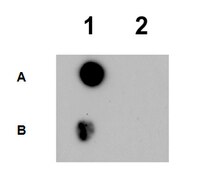ABE353 Sigma-AldrichAnti-dimethyl Histone H2B Antibody (Pro1)
This Anti-dimethyl Histone H2B Antibody (Pro1) is validated for use in Western Blotting and Immunocytochemistry and Dot Blot for the detection of dimethyl Histone H2B (Pro1).
More>> This Anti-dimethyl Histone H2B Antibody (Pro1) is validated for use in Western Blotting and Immunocytochemistry and Dot Blot for the detection of dimethyl Histone H2B (Pro1). Less<<Recommended Products
Overview
| Replacement Information |
|---|
Key Specifications Table
| Species Reactivity | Key Applications | Host | Format | Antibody Type |
|---|---|---|---|---|
| H, M | WB, ICC, DB | Rb | Affinity Purified | Polyclonal Antibody |
| References |
|---|
| Product Information | |
|---|---|
| Format | Affinity Purified |
| Presentation | Purified rabbit Polyclonal antibody in buffer containing 0.1 M Tris-Glycine (pH 7.4), 150 mM NaCl with 0.05% sodium azide. |
| Quality Level | MQ100 |
| Physicochemical Information |
|---|
| Dimensions |
|---|
| Materials Information |
|---|
| Toxicological Information |
|---|
| Safety Information according to GHS |
|---|
| Safety Information |
|---|
| Storage and Shipping Information | |
|---|---|
| Storage Conditions | Stable for 1 year at 2-8°C from date of receipt. |
| Packaging Information | |
|---|---|
| Material Size | 100 µg |
| Transport Information |
|---|
| Supplemental Information |
|---|
| Specifications |
|---|
| Global Trade Item Number | |
|---|---|
| Catalog Number | GTIN |
| ABE353 | 04053252985225 |
Documentation
Anti-dimethyl Histone H2B Antibody (Pro1) SDS
| Title |
|---|
Anti-dimethyl Histone H2B Antibody (Pro1) Certificates of Analysis
| Title | Lot Number |
|---|---|
| Anti-dimethyl Histone H2B (Pro1) - Q2445321 | Q2445321 |
| Anti-dimethyl Histone H2B (Pro1) - 3521911 | 3521911 |
| Anti-dimethyl Histone H2B (Pro1) - 3525924 | 3525924 |









